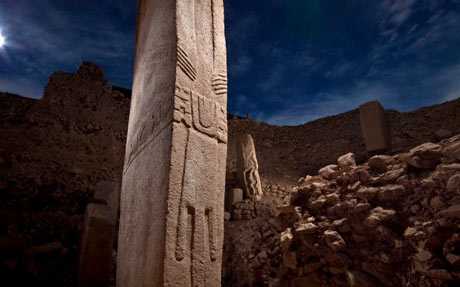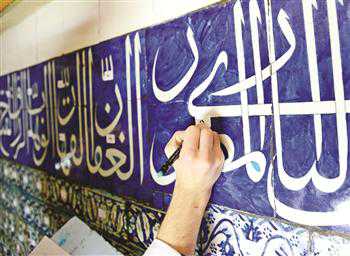Given the power to travel in time, which period would you choose for your tour? Well, here’s one to consider: the early Holocene. Not grabbing you? Well, to be more precise 9,600BC in what is now eastern Turkey. That period and place are known to have been pivotal in human prehistory, although they left precious few traces.
It was during this time that certain plants and animals were domesticated, which led to the farming revolution and permanent changes in human technology, culture and diet. It was the moment, in short, when humanity started on the inexorable ascent towards pot noodles and oven chips. What better moment could there be to delve into? And now, thanks to some incredible recent discoveries close to the ancient city of Urfa (officially now Sanlıurfa, but usually called simply Urfa), we have a tangible physical trace of that momentous turning point in humanity’s development.
One morning in 1994, Professor Klaus Schmidt of the German Archaeological Institute in Istanbul, went for a walk in a range of low hills nine miles north-east of Urfa. It was not exactly an aimless amble: Schmidt had been excavating several neolithic sites in the area and was on the hunt for more. In his pocket was a list of interesting locations generated by a 1960s survey. One, marked as of minor interest, was a small hill, Gobëkli Tepe, the “belly-shaped mound”. Approaching it, Schmidt saw something promising in the shape: “It was clearly manmade.”
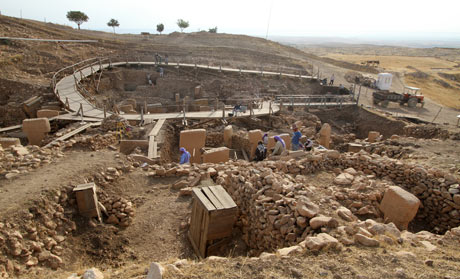 The current dig near Urfa, Turkey. Photographs by Kevin Rushby for the GuardianThe hills in this area are given over to sheep and goats, while the valley below is the scene of intensive mechanised agriculture, crisscrossed by massive concrete irrigation canals. The agrarian revolution has hardly had a beautifying effect here in its original home, but Schmidt knew this had once been a rich savannah, alive with wild animals and birds. As he reached the highest point, he began to pick up flint arrowheads, dozens of them.
The current dig near Urfa, Turkey. Photographs by Kevin Rushby for the GuardianThe hills in this area are given over to sheep and goats, while the valley below is the scene of intensive mechanised agriculture, crisscrossed by massive concrete irrigation canals. The agrarian revolution has hardly had a beautifying effect here in its original home, but Schmidt knew this had once been a rich savannah, alive with wild animals and birds. As he reached the highest point, he began to pick up flint arrowheads, dozens of them.
Local landowner Mahmut Yildiz, who was with him, led him to the only tree on the hill, right at the top. It was tied with ribbons, and Yildiz told how locals believed it was a holy site. Schmidt spotted several large rocks about a metre long and a third as wide. A quick inspection suggested these were manmade, and ancient.
“I knew right then,” Schmidt tells me as we survey the site, “that this place would occupy me for the rest of my life.”
What he had found was the most significant stone age discovery of the century, perhaps of all time. The large monoliths proved to be the tops of five-metre-high standing stones, vaguely human-shaped but carved with animal figures. Radar investigation revealed the stones to be laid in a circle, and that there were a further 20 such circles.
When the first carbon-dating was done, the results were staggering. Gobëkli Tepe was between 10,800 and 11,600 years old, making it the most ancient monument ever found by more than five millennia. According to the textbooks it could not exist: human hunter-gatherer societies at that time simply did not possess the skills and resources to construct such a place. But here it was, a stone age marvel that had ripped up those very textbooks.
And what was it? Temple? Burial mound? Meeting hall? No one knew. But one thing was certain: Gobëkli Tepe would one day be known to every schoolchild on earth and was destined to become a major travel destination, ranked alongside the Great Pyramids, Persepolis and Stonehenge.
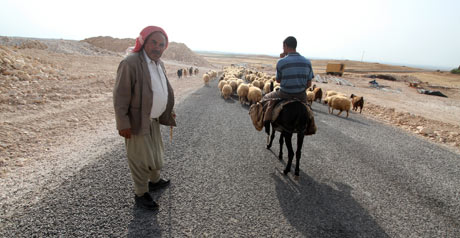 Shepherds on the road near Gobëckli TepeThese days you drive up to the site, and the stony ground has been cleared sufficiently for the occasional tourist bus to park. Word is starting to spread. Yildiz has brought in a makeshift table and sells postcards and books. Most days he has a few customers, sometimes several dozen.
Shepherds on the road near Gobëckli TepeThese days you drive up to the site, and the stony ground has been cleared sufficiently for the occasional tourist bus to park. Word is starting to spread. Yildiz has brought in a makeshift table and sells postcards and books. Most days he has a few customers, sometimes several dozen.
As you approach the site, you see a few huts but not much else. The ground is still dotted with arrow flints. Then you round the hill. Even if you’ve seen the pictures of the site on the internet, it is quite extraordinary: an area of hillside the size of three tennis courts dug out to a depth of seven or eight metres to reveal dozens of huge monoliths. There is a raised boardwalk so you can move over the area easily, watching the archaeologists at work.
The astonishing thing here is that so much is unknown: any visitor can have an opinion. Is that carving of a fox or a wolf? Was the site ever roofed? Why have no human bones been found?
I arrive just after dawn and, by good fortune, find Schmidt there. “We are expecting to find burials,” he says, “in the walls, perhaps.”
From the beginning, Schmidt has insisted that visitors be allowed on the site. “When word got out and people were arriving from all over the world,” he says, “I knew we had to let them see what was here.”
We walk together along the boardwalk. Teams of local men are digging with long-handled shovels, shaving away at the layers. Our conversation is interrupted continually as the professor is called away to look at finds or comment on progress. I wait for him, examining the stones carefully. What had appeared at first to be rectangular stones I now see are actually T-shaped, giving the sense of a “head” on top. Halfway down the side are parallel notches that look like fingers resting on a belt from which hangs a carved loincloth.
“It’s clear the stones are anthropomorphic,” says the professor when he returns to me. “But they are faceless – monumental spirits, or mythical ancestors, or gods. On them are carved animals – snakes, boars, foxes, spiders.”
These are not the animals the people would have hunted. A line of ducks on one stone looks positively pastoral, nothing like those cave paintings showing human hunting expeditions, with the quarry fleeing from stick-like figures waving spears.
“The carved animals are clearly aspects of the T-shaped figures,” says Schmidt. “They are the animals we would find in fairy tales.”
One of the assistants comes over to discuss progress with the professor. I stand admiring the carvings. Here are the very creatures that we still use as archetypes: the busy spider, the cunning fox, the majestic lion. It gives the mysterious faceless figures an oddly familiar look. I feel I would recognise the people who made them, and with an able translator, understand their stories, perhaps even their jokes.
The professor is clearly not coming back to me for a while. It’s an indication of how much interest the site is generating that he is expecting a party of 60 academics from all over the world. I set off around the site, exploring the hilltop, where the tree still bears a few scarves left by local women as fertility offerings.
In olive groves on the far side, flint arrowheads litter the ground, and I can see the places where the archaeologists have cut experimental holes to reveal the tops of more monumental stones. There is obviously work enough for several generations of archaeologists to get their teeth into. When I finally say goodbye to Professor Schmidt, he agrees: “I’ve been working here for 18 years and there is a routine, but there is still excitement too. Every campaign we discover more. There’s at least 50 years’ worth of research here.”
I’d arrived by taxi, probably the simplest method, from Urfa, and I head back there. There is another ancient site I want to visit in the centre of town, a place that seems an appropriate corollary to Gobëkli Tepe. I also want some lunch.
 A pastry shop in UrfaNow a bustling modern place, Urfa has an ancient heart. I’m dropped off in the old town then walk through the bazaar, a wonderful labyrinth of alleyways and shops. As befits a place so close to the birthplace of the modern diet, there are restaurants galore: each with a spread of low stools and tables outside. I order ciger (liver), then set about chopping up my own salad with the piles of onions, coriander, lemons and mint provided. A giant flatbread is brought and a pewter bowl of ayran, buttermilk.
A pastry shop in UrfaNow a bustling modern place, Urfa has an ancient heart. I’m dropped off in the old town then walk through the bazaar, a wonderful labyrinth of alleyways and shops. As befits a place so close to the birthplace of the modern diet, there are restaurants galore: each with a spread of low stools and tables outside. I order ciger (liver), then set about chopping up my own salad with the piles of onions, coriander, lemons and mint provided. A giant flatbread is brought and a pewter bowl of ayran, buttermilk.
The salad is doused in sweet pomegranate sauce and the meat arrives, scorching hot from the grill. When I’ve finished, I move on to get tea and ask about one of Urfa’s specialities, sillik. This draws some chuckles as the word means “whore”, but eventually I find it: walnuts, pistachios and syrup rolled in a pancake. After a couple of these, I am ready to approach the city’s spiritual heart.
At the top of the bazaar, a broad stone-flagged path leads into a shady park enclosed on two sides by the narrowing valley. To the left, and above me, is the Byzantine citadel, to the right old houses, some of them now restored to be grand hotels and restaurants. In the centre of the park is a long limpid pool filled with blue-grey carp that are being fed by an army of children and parents.
To one side, right under the rock wall, is the entrance to a cave, the place I – and hundreds of others – have come to visit. It’s a stark contrast with the relative tranquillity of Gobëkli, but I sense that somehow this underground space is the opposing twin of that belly-shaped hill.
Several thousand years ago, so the local story goes, a pregnant woman sheltered from the wrath of a vengeful king in that cave and gave birth to a child who would become the patriarch Abraham – revered by Muslims, Jews and Christians. Unlike at Gobëkli Tepe, where there is solid evidence but almost no understanding of the story, the Abrahamic legend comes with no material evidence at all but a powerful and enduring narrative of a journey. The patriarch is supposed to have left the cradle of civilisation for a new land, Canaan, a country that would fascinate and obsess humanity right down to the present day.
I had visited the end point of Abraham’s travels, his tomb in a subterranean complex in the Palestinian city of Hebron. Ironically, these chambers are now divided by stone walls, so that the man’s descendants don’t tear each other to pieces. Now I am at his birthplace and, entering, I discover that it too is divided, this time by a wooden screen to separate men and women.
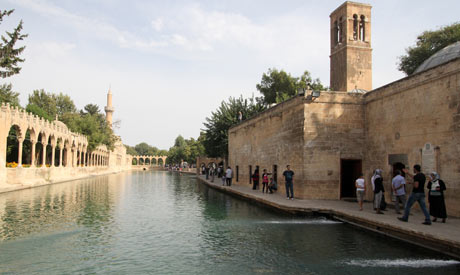 Abraham’s pool in UrfaAt the end of the tunnel is a grotto and a pool. On the carpeted floor several men are fervently praying. The story of Abraham certainly seems to have meaning and significance for them. As we leave together, I ask one man if he’s been to Gobëkli Tepe.
Abraham’s pool in UrfaAt the end of the tunnel is a grotto and a pool. On the carpeted floor several men are fervently praying. The story of Abraham certainly seems to have meaning and significance for them. As we leave together, I ask one man if he’s been to Gobëkli Tepe.
“No,” he says in halting English, “but I have heard of it, in the newspaper.”
Will he go? He shrugs and laughs. “It is just stones.”
On the adjacent hillside I find a flight of steps running up the hillside towards the Byzantine fortress. At the summit is an excellent view of the town and surrounding barren hills.
The agrarian revolution may have started in this area, but it has not blessed these hills with much. Most of the trees are long gone. There are few wild animals or birds. The outskirts of Urfa are a desert of dusty concrete apartment blocks. I suppose you could argue that the great myth that sprang from the same area hasn’t done anyone much good either: pogroms, crusades, cleansings and endless violence are one way of seeing the cursed inheritance of Abraham’s children.
I sit down on the grass, somber with such thoughts, to watch the sunset. Only then do I notice, next to me, a family out for a picnic. The children are being served a delicious-looking array of homemade dishes by their mother and older sisters while the father, reclining jovially with a hookah pipe, is tending to his pet partridges, brought along to enjoy the air and the grass. And everyone is laughing.
The trip was provided by Explore (0844 875 1892, explore.co.uk), whose 15-day Eastern Turkey small group includes a visit to Gobëkli Tepe. It costs from £1,246 per person, including flights, B&B accommodation, transport and the services of a tour leader tour, and there are numerous departure dates from May to September 2013.
Kevin travelled from York to London with East Coast Mainline (08457 225225, eastcoast.co.uk), which has advance returns, booked online, from £26.
Source : https://www.theguardian.com/travel/2012/dec/21/eastern-turkey-ancient-wonders
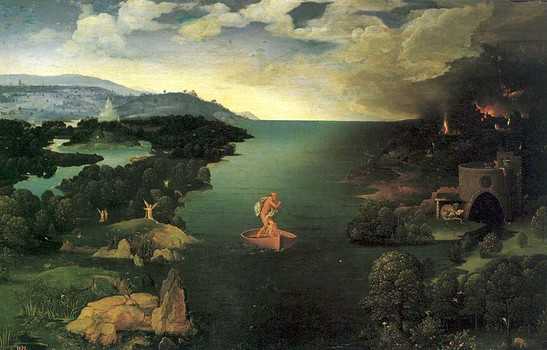

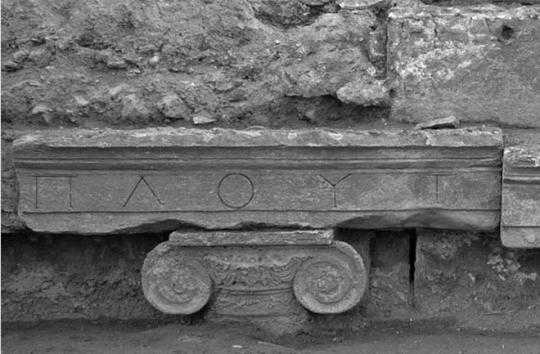
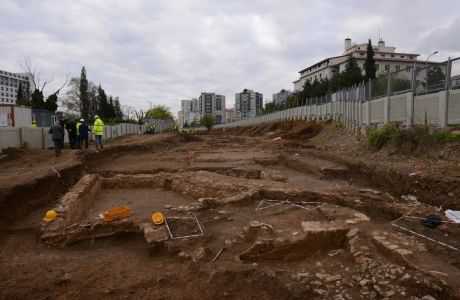

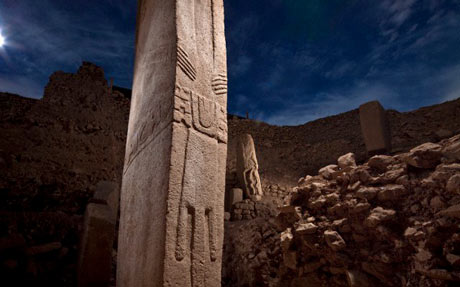
 The current dig near Urfa, Turkey. Photographs by Kevin Rushby for the GuardianThe hills in this area are given over to sheep and goats, while the valley below is the scene of intensive mechanised agriculture, crisscrossed by massive concrete irrigation canals. The agrarian revolution has hardly had a beautifying effect here in its original home, but Schmidt knew this had once been a rich savannah, alive with wild animals and birds. As he reached the highest point, he began to pick up flint arrowheads, dozens of them.
The current dig near Urfa, Turkey. Photographs by Kevin Rushby for the GuardianThe hills in this area are given over to sheep and goats, while the valley below is the scene of intensive mechanised agriculture, crisscrossed by massive concrete irrigation canals. The agrarian revolution has hardly had a beautifying effect here in its original home, but Schmidt knew this had once been a rich savannah, alive with wild animals and birds. As he reached the highest point, he began to pick up flint arrowheads, dozens of them. Shepherds on the road near Gobëckli TepeThese days you drive up to the site, and the stony ground has been cleared sufficiently for the occasional tourist bus to park. Word is starting to spread. Yildiz has brought in a makeshift table and sells postcards and books. Most days he has a few customers, sometimes several dozen.
Shepherds on the road near Gobëckli TepeThese days you drive up to the site, and the stony ground has been cleared sufficiently for the occasional tourist bus to park. Word is starting to spread. Yildiz has brought in a makeshift table and sells postcards and books. Most days he has a few customers, sometimes several dozen. A pastry shop in UrfaNow a bustling modern place, Urfa has an ancient heart. I’m dropped off in the old town then walk through the bazaar, a wonderful labyrinth of alleyways and shops. As befits a place so close to the birthplace of the modern diet, there are restaurants galore: each with a spread of low stools and tables outside. I order ciger (liver), then set about chopping up my own salad with the piles of onions, coriander, lemons and mint provided. A giant flatbread is brought and a pewter bowl of ayran, buttermilk.
A pastry shop in UrfaNow a bustling modern place, Urfa has an ancient heart. I’m dropped off in the old town then walk through the bazaar, a wonderful labyrinth of alleyways and shops. As befits a place so close to the birthplace of the modern diet, there are restaurants galore: each with a spread of low stools and tables outside. I order ciger (liver), then set about chopping up my own salad with the piles of onions, coriander, lemons and mint provided. A giant flatbread is brought and a pewter bowl of ayran, buttermilk. Abraham’s pool in UrfaAt the end of the tunnel is a grotto and a pool. On the carpeted floor several men are fervently praying. The story of Abraham certainly seems to have meaning and significance for them. As we leave together, I ask one man if he’s been to Gobëkli Tepe.
Abraham’s pool in UrfaAt the end of the tunnel is a grotto and a pool. On the carpeted floor several men are fervently praying. The story of Abraham certainly seems to have meaning and significance for them. As we leave together, I ask one man if he’s been to Gobëkli Tepe.